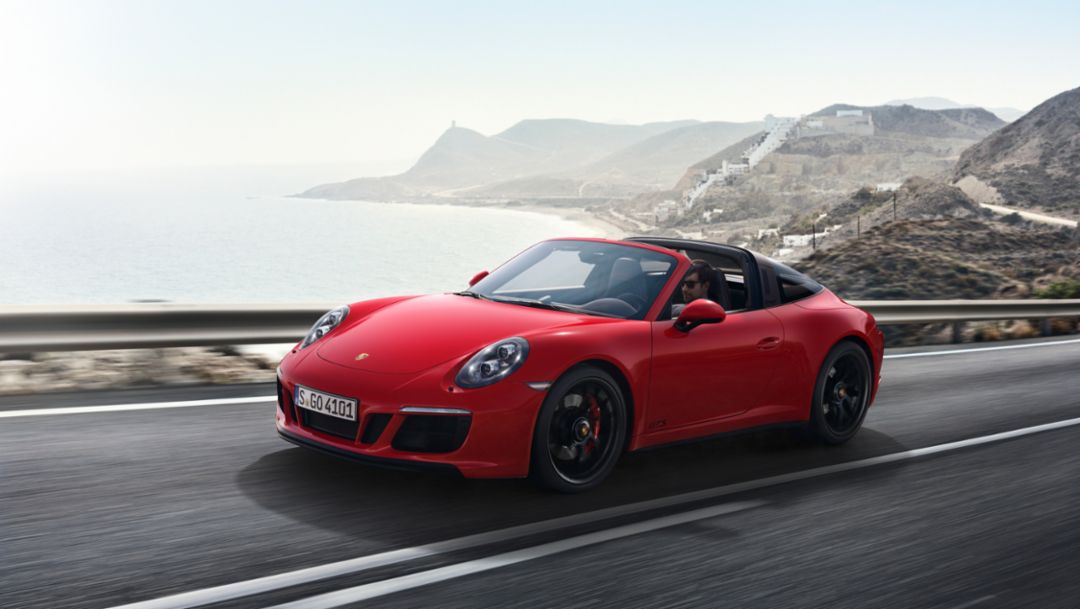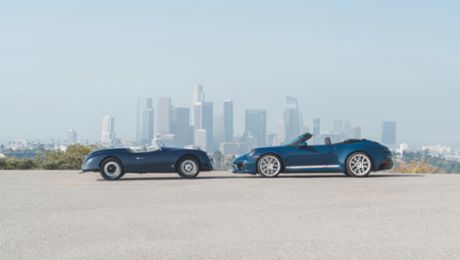From March 2017, a total of five variants will be available in Germany: the 911 Carrera GTS with rear-wheel drive, the 911 Carrera 4 GTS with all-wheel drive – both of the above available as a Coupé and Cabriolet – and the 911 Targa 4 GTS with all-wheel drive. A newly developed turbocharger for 3.0-litre six-cylinder flat engine increases power to 331 kW/450 hp (911 Carrera GTS: combined fuel consumption 9.4–8.3 l/100 km; CO2 emissions 214–188g/km; 911 Carrera 4 GTS: combined fuel consumption 9.7–8.5 l/100 km; CO2 emissions 220–192g/km; 911 Targa 4 GTS: combined fuel consumption 9.7 – 8.7 l/100 km; CO2 emissions 220 – 196 g/km). The engine delivers 22 kW (30 hp) more than the 911 Carrera S (combined fuel consumption 8.7 – 7.7 l/100 km; CO2-emissions 199 – 174 g/km) and 15 kW (20 hp) more than the corresponding GTS prior model with a naturally aspirated engine. All variants are available with a manual seven-gear transmission or optional Porsche Doppelkupplung (PDK).
More power for more performance
The maximum torque of 550 Nm provides even better acceleration and elasticity figures. The torque is available between 2150 and 5000 rpm. Porsche Active Suspension Management (PASM) is included as standard on all GTS models. The GTS Coupés feature the PASM sports chassis, which lowers the body by ten millimetres. The fastest sprinter in the family is the 911 Carrera 4 GTS Coupé: With Porsche Doppelkupplung (PDK) and the Sport Chrono Package as standard, it races from zero to 100 km/h in 3.6 seconds (combined fuel consumption 9.5 – 8.5 l/100 km; CO2 emissions 216 – 192 g/km). All GTS models feature a top speed in excess of 300 km/h. The front-runner at 312 km/h is the Coupé with manual transmission and rear-wheel drive. Despite the increase in performance, the GTS remains efficient – the 911 Carrera GTS with PDK, for example, consumes only 8.3 l/100 km according to the NEDC. This corresponds to CO2 emissions of 188 g/km.
Typical GTS: Numerous black elements both inside and out
The GTS models stand out within the 911 model line not only in terms of technology, but also in their visual design: All of the vehicles are based on the wide all-wheel-drive chassis, which measures 1852 mm even on the rear-wheel-drive models. The new Sport Design front apron emphasises the sporty character. The front end is aerodynamically optimised. A low front spoiler and increased rear spoiler extension height further reduce the lift forces on the front and rear axle compared to the Carrera S models. On the rear, the GTS is unmistakeable: smoked tail lights, silk-gloss black air intake grille and central black twin tailpipes of the sports exhaust system, which is included as standard.
A new black trim strip between the tail lights characterises the rear-wheel-drive models. The light strip is reserved for the all-wheel-drive models. Sport Design exterior mirrors, 20-inch wheels with central locking device painted in silk-gloss black, plus GTS logos on the doors complete the side view. The characteristic Targa bar, which is supplied in black for the first time on the GTS, also lends the 911 Targa a particularly distinctive look.
New Porsche Track Precision app and high-quality equipment
GTS genes also shape the interior. The stopwatch of the Sport Chrono Package is integrated as a central component of the dashboard. The Porsche Track Precision app has been further enhanced specially to coincide with the market launch of the GTS models. Its features include automatic recording, detailed display and analysis of driving data on a smartphone. GTS passengers sit on Alcantara seats with a new stitching pattern. The Sports seats Plus with GTS logos on the headrests can be adjusted in 4-ways electrically and provide increased lateral support and comfort. Other features include brushed, black anodised aluminium trim strips on the instrument cluster as well as a high proportion of Alcantara, which can be found on the steering wheel rim, centre console and armrests, for example.
Consumption data
911 Carrera GTS: Fuel consumption combined 9.4 – 8.3 l/100 km; CO2-emissions 212 – 188 g/km
911 Carrera GTS Cabriolet: Fuel consumption combined 9.4 – 8.4 l/100 km; CO2-emissions 214 – 190 g/km
911 Carrera 4 GTS: Fuel consumption combined 9.5 – 8.5 l/100 km; CO2-emissions 216 – 192 g/km
911 Carrera 4 GTS Cabriolet: Fuel consumption combined 9.7 – 8.7 l/100 km; CO2-emissions 220 – 196 g/km
911 Targa 4 GTS: Fuel consumption combined 9.7 – 8.7 l/100 km; CO2-emissions 220 – 196 g/km
911 Carrera S: Fuel consumption combined 8.7 – 7.7 l/100 km; CO2-emissions 199 – 174 g/km
911 Carrera 4 GTS: Fuel consumption combined 9.5 – 8.5 l/100 km; CO2-emissions 216 – 192 g/km



